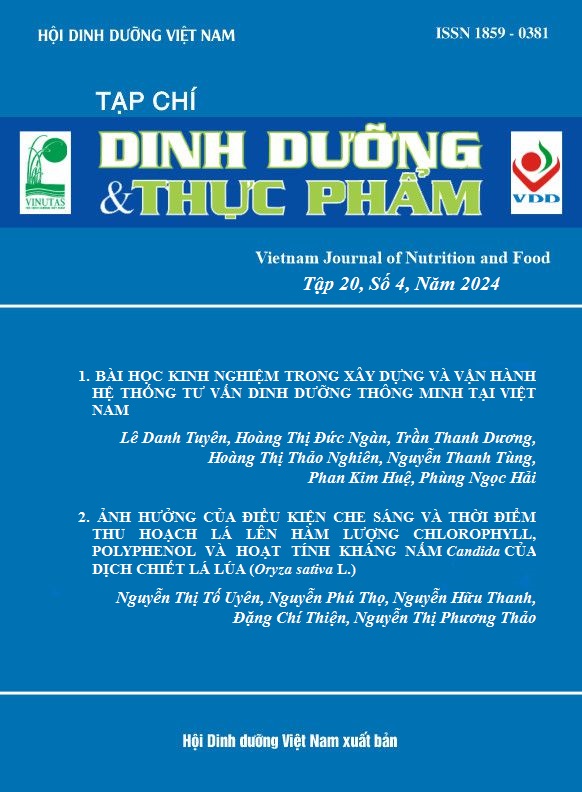RESEARCH ON THE USE OF NATURAL ORIGIN ADDITIVES AND NECESSARY MICRONUTRIENTS IN PROCESSING OF BIG SAUSAGE “GIO LUA”
Main Article Content
Abstract
Aims: This study aimed to identify safe, natural additives with appropriate concentration to replace borax - an additive banned by the Ministry of Health in 2003, to stiffen big sausage “gio lua” and to determine the percentage of calcium and vitamin D added to the product.
Methods: The tested additives were modified starch, chitofood and soybean germ meal in different concentrations (0.0, 0.5, 1.0 and 1.5%). The micronutrient contents of calcium and vitamin D were investigated including 0 µg/100g and 0 µg/100g, 3 µg/100g and 210 µg/100g, 4 µg/100g and 280 µg/100g, 5 µg/100g and 350 µg/100g.
The study used popular and modern analytical methods such as the determination of moisture by drying method to constant weight, protein content by Kjeldhal method (TCVN 10034:2013), lipid content by Shoxlet method (TCVN 4592: 1988), vitamin D content determined using HPLC (TCVN 8973: 2011), calcium content determined by atomic absorption spectroscopy (TCVN 10916: 2015).
Results: The modified starch with the addition rate of 1% was selected to create a crunchy texture for the product and a reasonable price. The contents of calcium and vitamin D supplementation were 4 mcg/100g and 280 mg/100g, respectively. The steamed big sausage “gio lua” had calcium and vitamin D content of 3.52 mcg/100g and 274.52 mg/100g.
Conclusion: The most suitable additive ratio of natural origin for processing pork sausage is 1% modified starch for a product with good nutritional quality, structure, and sensory quality.
Keywords
Gio lua, nature original additive, micronutrients
Article Details
References
2. Bekhit, Alaa El-Din A., ed. Advances in meat processing technology. CRC Press, 2017.
3. Bộ nông nghiệp và phát triển nông thôn. “Công nghệ sản xuất giò chả”, NXB Sở KH&CN tỉnh Bình Dương, 2016.
4. Nguyễn Văn Mười. "Giáo trình Công nghệ chế biến thịt và sản phẩm thịt, Khoa nông nghiệp và sinh học ứng dụng." Trường Đại học Cần Thơ, 2004.
5. Nguyễn Duy Thịnh.“Các chất phụ gia dùng trong sản xuất thực phẩm”, NXB Bách Khoa, Hà Nội, 2004
6. Lê Ngọc Tú, “Hóa học thực phẩm”. NXB Khoa học và kỹ thuật, Hà Nội, 1994.
7. Lê Ngọc Tú, “Cơ sở của phương pháp tạo cấu trúc cho các sản phẩm thực phẩm”, NXB Bách Khoa, Hà Nội, 2015.
8. Hà Duyên Tư. “Phân tích hóa học thực phẩm”, NXB Khoa học và kỹ thuật, Hà Nội, 2013.
9. Điều tra về vi chất dinh dưỡng. Viện dinh dưỡng, Hà Nội, 2023
https://chuyentrang.viendinhduong.vn/vi/so-lieu-thong-ke/so-lieu-thong-ke-266.html
10. TCVN 10034:2013- Thực phẩm và thức ăn chăn nuôi - Hướng dẫn chung về xác định hàm lượng nitơ bằng phương pháp kjeldahl
11. TCVN 4592:1988 - Đồ hộp - Phương pháp xác định hàm lượng lipit tự do và lipit tổng số
12. TCVN 8973:2011 - Thực phẩm - Xác định vitamin D bằng sắc ký lỏng hiệu năng cao - Xác định cholecalciferol (D3) hoặc Ergocalciferol (D2)
13. TCVN 10916 : 2015 - Thực phẩm - Xác định các chất khoáng trong thức ăn và thực phẩm dinh dưỡng đặc biệt - Phương pháp quang phổ hấp thụ nguyên tử
14. TCVN 3215-79 - Sản phẩm thực phẩm phân tích cảm quan - Phương pháp cho điểm.
Similar Articles
- Ha Vi HOANG, Thi Thu Ha LE, Mai Phuong Anh KIEU, NEEDS FOR NUTRITION COUNSELING OF LUNG CANCER PATIENTS UNDERGOING TREATMENT AT HANOI ONCOLOGY HOSPITAL , Vietnam Journal of Nutrition & Food: Vol. 19 No. 4+5 (2023)
You may also start an advanced similarity search for this article.


